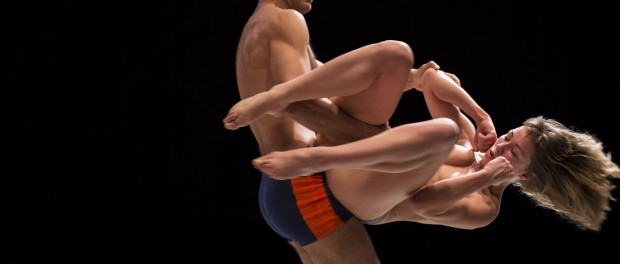Dance Review : Léveillé’s Erotic, Athletic Duos
Solitudes Duo, as you probably can guess from the title, pairs dancers together. The six different choreographies are as much an athletic performance as dance. Léveillé twines together the two (dance and athleticism) to craft erotically charged sequences that express aggression, lust, rejection, and even affection.
Like other works by Léveillé, there is no set – just the black box theatre, the white square on which the dancers perform (and sometimes roll off of). The music is a combination of classical and contemporary music (I don’t want to give away, but the two contemporary pieces are spot on), though the dancers perform even as the music stops and changes. Their only “costume” for most sequences are body hugging underpants. As a result, the “costume” is the human body, with the dancer stripped to showcase as much of the body as possible. Women even perform some choreographies topless. As a result, every muscle flexes, extends, shakes, and relaxes in plain view. Scars, tattoos, birth marks, beards — all are visible. While nearly naked dancers might seem initially squirmy to sit through, it allows for an intimacy with the performance. In the sequences that utilize clothing, the t-shirts and shorts distance the dance by generating more of a narrative. As an example, a shirt with Che Guevara is suggestive of a time, a place, a personality for the particular dancer.
The duos perform the choreography in a fugue-like manner, building their routines out of repeating motifs sometimes performed in tandem, sometimes deliberately off-sync, and sometimes echoing each other. There are signature moves, postures, and steps that I recognize from Lévillé’s earlier works though I would be hard pressed to give them a name: the anemone? the water bug? These moves have incredible power, as even a single gestureor posture evokes much emotion. A leg extended towards the shoulder is used to push another away. A leap into a wide-legged squat suggests a challenge. Hands held defensively at the chest, aggression. A leap onto the body of another, desperation or lust. I am awed how much is created out of such unadorned movement.
Though Léveillé says he remains neutral in what he asks of his dancers, it’s inevitable to assign specific human relationships to each duo. Just pairing same sex and crossed sex dancers together suggests a narrative to the relationship. Some that I interpreted are a couple that is over its honeymoon phase, the effect of an overpowering lover, pure lust, and a first taste of sexual freedom. The music enhances these sensations as well.
Another theme is how Léveillé draws on the animal world, though I’d be hard pressed to name a specific animal intended. The movements are primal: creeping, crawling, flapping, leaping, humping, leering, challenging. A hip grind is a tool to seduce, and when exaggerated through a full body circle of the torso and buttocks becomes almost a Wild Kingdom come-hither display for mates. The members of each pair spend a good deal of their time in contact with each other, gripping tight to each other’s bodies, rolling on each other, collapsing on each other. They link their legs and arms around each other’s torsos, then flop down side by side as if exhausted from copulation. The motions are highly sexualized and erotic.
The physicality of the piece is defining, and something it has in common with Léveillé’s other works. This is is not graceful, angel farting glitter dance. The dancers come hard down on their feet, as if there are magnets pulling them to the earth. They strain and grunt as they hoist each other up, carry one another on their backs, roll out of headstands. Though the dancers go through sequences that are more graceful and artful, this is not the emphasis. Movements happen quickly, almost viciously, instinctually. The beauty is not about effortlessness and weightlessness. It isn’t in the exact synchronization and similitude either. No dancer takes the same choreography in the same way as his fellows. Their individuality is on display in all its excellence and failing. Léveillé challenges his dancers to go to their limits, to do things that are physically perhaps just at the edge of their capabilities. Then again, stripped to their undergarments, there is nowhere to hide. The dancers are fully on display in all their vulnerability. The audience, too, has nothing to hide behind either.
Léveillé has created another masterful work with his signature style. The dancers do an outstanding job bringing life and movement to Léveillé’s ideas and deliver powerful emotions to all. Stripped dance back to its essence, removing all artifice, Léveillé creates a piece of great beauty that celebrates the human condition.
Solitudes Duo is at the Agora de la Danse tonight, May 28 as part of the FTA.






